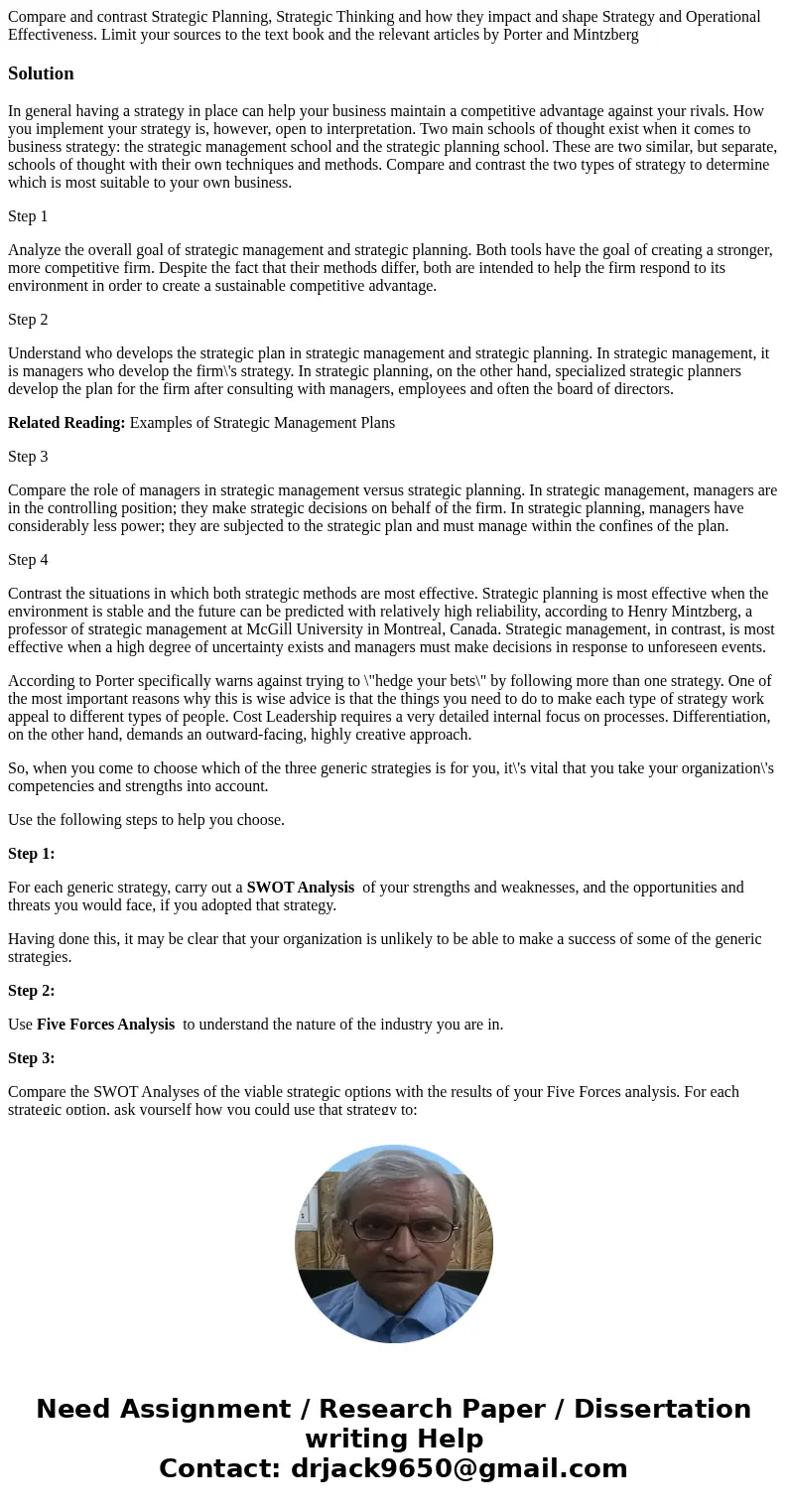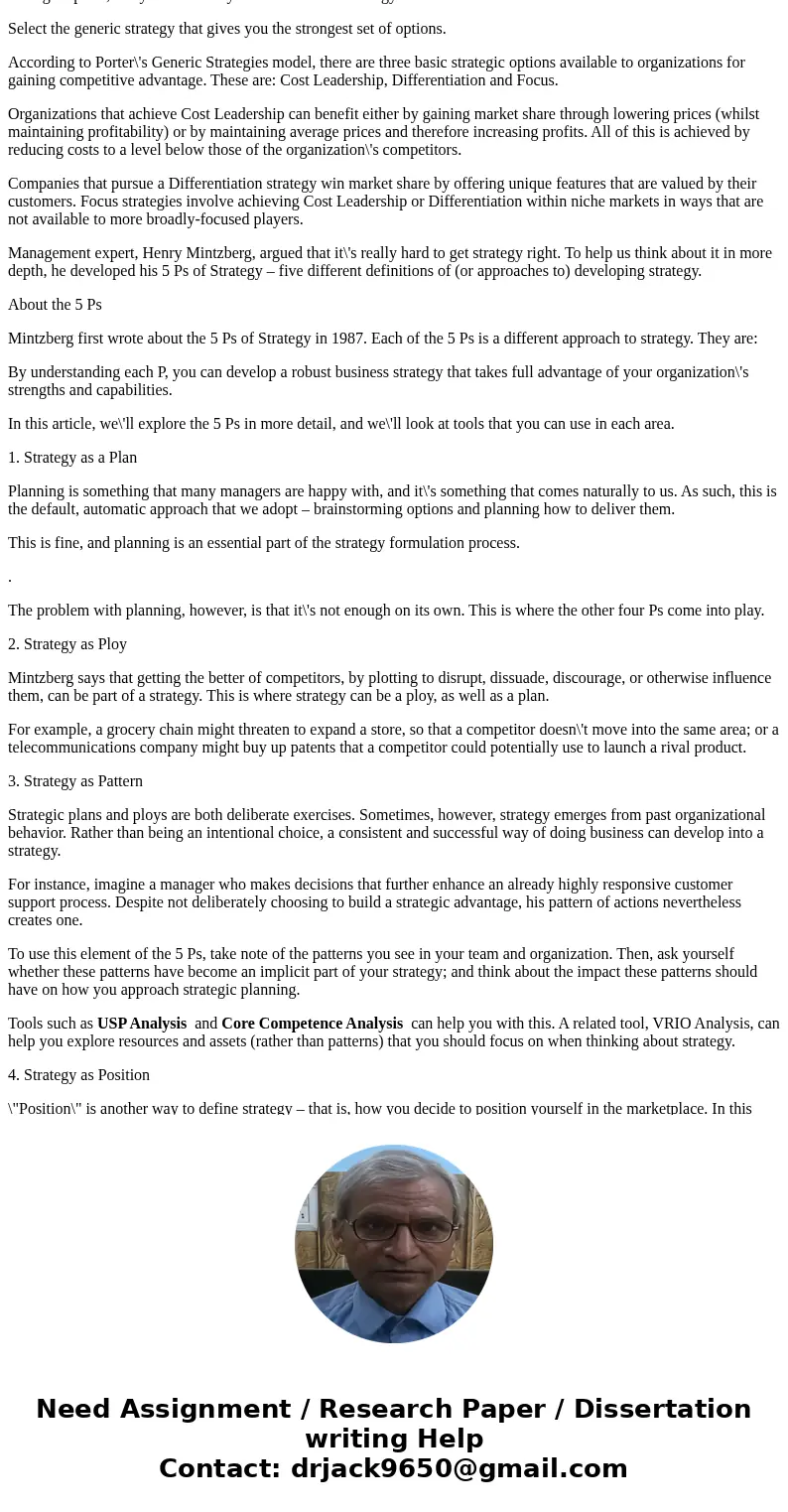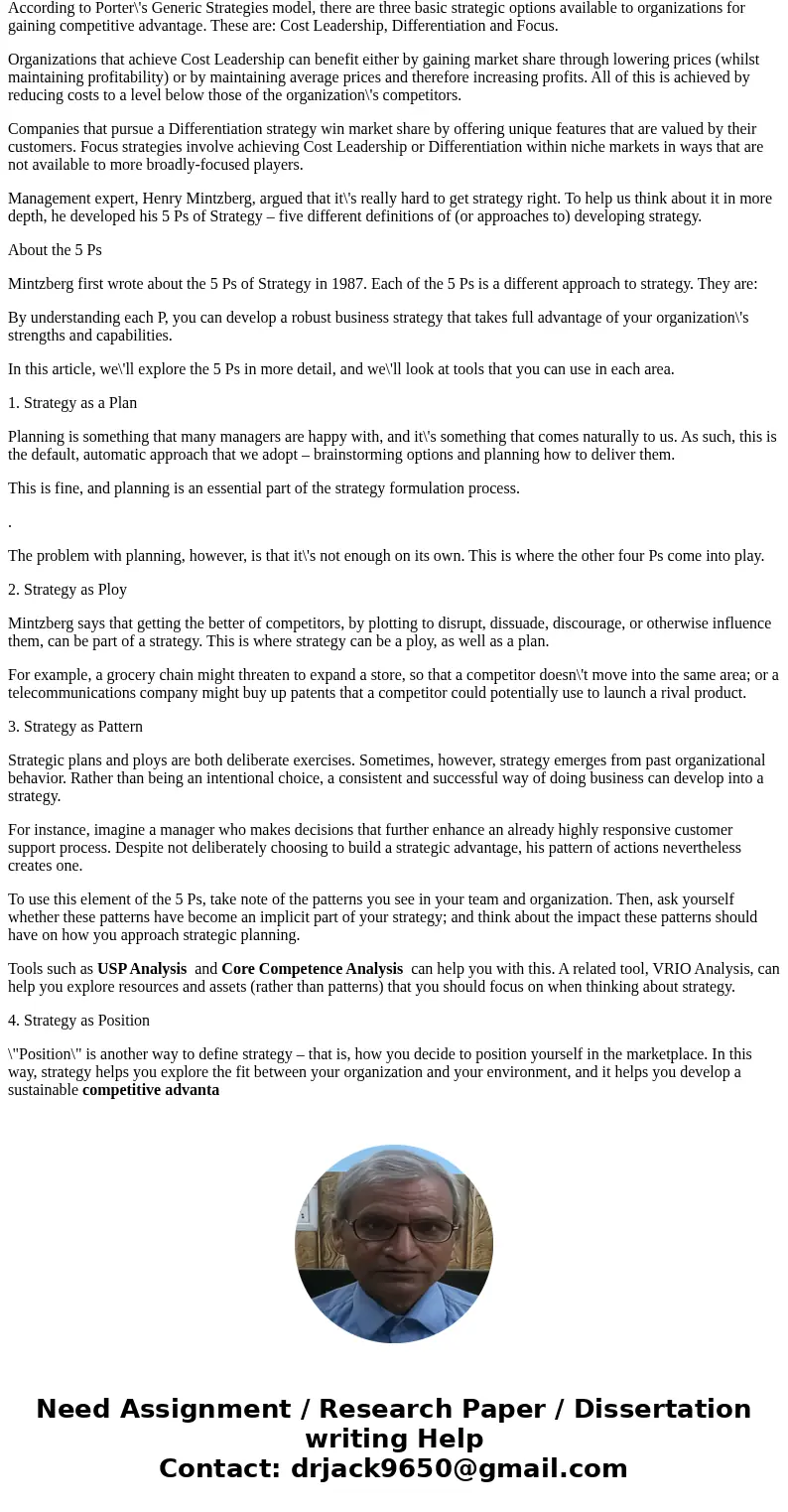Compare and contrast Strategic Planning Strategic Thinking a
Compare and contrast Strategic Planning, Strategic Thinking and how they impact and shape Strategy and Operational Effectiveness. Limit your sources to the text book and the relevant articles by Porter and Mintzberg
Solution
In general having a strategy in place can help your business maintain a competitive advantage against your rivals. How you implement your strategy is, however, open to interpretation. Two main schools of thought exist when it comes to business strategy: the strategic management school and the strategic planning school. These are two similar, but separate, schools of thought with their own techniques and methods. Compare and contrast the two types of strategy to determine which is most suitable to your own business.
Step 1
Analyze the overall goal of strategic management and strategic planning. Both tools have the goal of creating a stronger, more competitive firm. Despite the fact that their methods differ, both are intended to help the firm respond to its environment in order to create a sustainable competitive advantage.
Step 2
Understand who develops the strategic plan in strategic management and strategic planning. In strategic management, it is managers who develop the firm\'s strategy. In strategic planning, on the other hand, specialized strategic planners develop the plan for the firm after consulting with managers, employees and often the board of directors.
Related Reading: Examples of Strategic Management Plans
Step 3
Compare the role of managers in strategic management versus strategic planning. In strategic management, managers are in the controlling position; they make strategic decisions on behalf of the firm. In strategic planning, managers have considerably less power; they are subjected to the strategic plan and must manage within the confines of the plan.
Step 4
Contrast the situations in which both strategic methods are most effective. Strategic planning is most effective when the environment is stable and the future can be predicted with relatively high reliability, according to Henry Mintzberg, a professor of strategic management at McGill University in Montreal, Canada. Strategic management, in contrast, is most effective when a high degree of uncertainty exists and managers must make decisions in response to unforeseen events.
According to Porter specifically warns against trying to \"hedge your bets\" by following more than one strategy. One of the most important reasons why this is wise advice is that the things you need to do to make each type of strategy work appeal to different types of people. Cost Leadership requires a very detailed internal focus on processes. Differentiation, on the other hand, demands an outward-facing, highly creative approach.
So, when you come to choose which of the three generic strategies is for you, it\'s vital that you take your organization\'s competencies and strengths into account.
Use the following steps to help you choose.
Step 1:
For each generic strategy, carry out a SWOT Analysis of your strengths and weaknesses, and the opportunities and threats you would face, if you adopted that strategy.
Having done this, it may be clear that your organization is unlikely to be able to make a success of some of the generic strategies.
Step 2:
Use Five Forces Analysis to understand the nature of the industry you are in.
Step 3:
Compare the SWOT Analyses of the viable strategic options with the results of your Five Forces analysis. For each strategic option, ask yourself how you could use that strategy to:
Select the generic strategy that gives you the strongest set of options.
According to Porter\'s Generic Strategies model, there are three basic strategic options available to organizations for gaining competitive advantage. These are: Cost Leadership, Differentiation and Focus.
Organizations that achieve Cost Leadership can benefit either by gaining market share through lowering prices (whilst maintaining profitability) or by maintaining average prices and therefore increasing profits. All of this is achieved by reducing costs to a level below those of the organization\'s competitors.
Companies that pursue a Differentiation strategy win market share by offering unique features that are valued by their customers. Focus strategies involve achieving Cost Leadership or Differentiation within niche markets in ways that are not available to more broadly-focused players.
Management expert, Henry Mintzberg, argued that it\'s really hard to get strategy right. To help us think about it in more depth, he developed his 5 Ps of Strategy – five different definitions of (or approaches to) developing strategy.
About the 5 Ps
Mintzberg first wrote about the 5 Ps of Strategy in 1987. Each of the 5 Ps is a different approach to strategy. They are:
By understanding each P, you can develop a robust business strategy that takes full advantage of your organization\'s strengths and capabilities.
In this article, we\'ll explore the 5 Ps in more detail, and we\'ll look at tools that you can use in each area.
1. Strategy as a Plan
Planning is something that many managers are happy with, and it\'s something that comes naturally to us. As such, this is the default, automatic approach that we adopt – brainstorming options and planning how to deliver them.
This is fine, and planning is an essential part of the strategy formulation process.
.
The problem with planning, however, is that it\'s not enough on its own. This is where the other four Ps come into play.
2. Strategy as Ploy
Mintzberg says that getting the better of competitors, by plotting to disrupt, dissuade, discourage, or otherwise influence them, can be part of a strategy. This is where strategy can be a ploy, as well as a plan.
For example, a grocery chain might threaten to expand a store, so that a competitor doesn\'t move into the same area; or a telecommunications company might buy up patents that a competitor could potentially use to launch a rival product.
3. Strategy as Pattern
Strategic plans and ploys are both deliberate exercises. Sometimes, however, strategy emerges from past organizational behavior. Rather than being an intentional choice, a consistent and successful way of doing business can develop into a strategy.
For instance, imagine a manager who makes decisions that further enhance an already highly responsive customer support process. Despite not deliberately choosing to build a strategic advantage, his pattern of actions nevertheless creates one.
To use this element of the 5 Ps, take note of the patterns you see in your team and organization. Then, ask yourself whether these patterns have become an implicit part of your strategy; and think about the impact these patterns should have on how you approach strategic planning.
Tools such as USP Analysis and Core Competence Analysis can help you with this. A related tool, VRIO Analysis, can help you explore resources and assets (rather than patterns) that you should focus on when thinking about strategy.
4. Strategy as Position
\"Position\" is another way to define strategy – that is, how you decide to position yourself in the marketplace. In this way, strategy helps you explore the fit between your organization and your environment, and it helps you develop a sustainable competitive advanta



 Homework Sourse
Homework Sourse